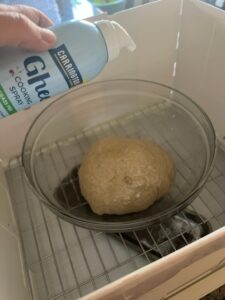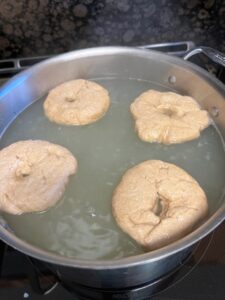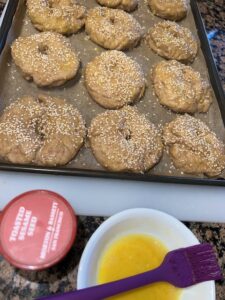I got into making bagels over 30 years ago when I moved from the East to the West Coast. At that time, the only bagels were in the freezer section at the grocery store and they were not very good. In college, I was lucky to become acquainted with “real” bagels from NYC. A dorm friend who came from the city, would bring them back whenever she went home.
The first time I tried my hand at making bagels after I had moved out West, I left them on the counter to cool while I went out to run an errand. My black lab, who had moved with me from the East to the West, must have had a hankering for a good bagel too as she enjoyed all of them while I was out.
I am as fond of making bagels as I am of eating them. It seems like this passion for making bagels may be shared by many others as one of my most-read blog posts is from January 2009 -it is about making pumpkin bagels.
While I initially got into making bagels because it was difficult to find a good bagel, now I make them because the conventional wheat used to make commercial bagels causes me intestinal distress. I can easily digest sprouted organic wheat berries, so have perfected making amazing bagels using sprouted grains. Like the other sprouted grain recipes, it took a little tweaking to get a bagel as good as the ones from my college days.
Potato Water
Using “potato water” for the moisture in bagel dough helps to create a stiffer dough (required for the bagel to withstand being boiled before being baked). I also use the potato water in the last step with making bagels – which is to boil them 30 seconds on each side. Boiling bagels causes the outside of the bagel to gelatinize that makes a soft but stiff crust. This soft crust also allows the bagel to steam off during baking, limiting how much a bagel can rise creating the classic dense chewy crumb.
Spice Mama Tip – Make the potato water in a large stock pot to use the same water to boil the bagels just before baking.
Ingredients
- 1 gallon of filtered water
- 2 peeled potatoes cut into 2 inch pieces.
Directions
- Put the potatoes and water in a large stock pot.
- Boil the potatoes until soft.
- Mash the potatoes in the water.
- Let the water cool until it’s tepid (100 degrees)
Bagel Dough
Gluten creates elasticity in bread dough. While kneading and proofing strengthen the gluten, to create a chewy bagel, though requires more gluten than ordinary bread. To increase the gluten level, it’s common to use high protein (13 to 14%) flours since these have higher gluten levels. The Hard Red Winter Wheat berries, I sprout, have a protein content of 10 – 13% and sprouting increases the protein by 10%.
This recipe uses 1 cup of soft white to 2 1/2 cups of hard red. I found if using all hard red wheat, the bagel had a rougher, more grainy texture and the flavor was “too earthy.” Balancing out the flour with the soft white wheat gives a better texture and more refined flavor. Soft wheat berries though are lower in gluten.
Spice Mama Tip – The challenge with using sprouted wheat is knowing the specific protein content. To create a more consistent chewiness with the variability in protein content from sprouting wheat berries, add in vital wheat gluten. For this recipe, add 1/2 cup of vital wheat gluten.
Spice Mama Tip – Another ingredient that helps with improving the consistency of results with making bagels is using a teaspoon of diastatic malt powder. Commercial flours have this added to help yeast ferment better, improving the rise – especially in the oven. Because boiling bagels create a soft crust that limits the rise in the oven, the diastatic malt powder makes it rise just enough so you have a little heft, but not too much. The oven rising activity is a delicate dance and this makes sprouted grain bagels rise just enough, but not too much so it’s chewy like a bagel rather than gooey, grainy, or too fluffy.
 Ingredients
Ingredients
- 1 cup of sprouted soft white wheat berries
- 2 1/2 cups of sprouted hard red wheat berries
- 1/2 cup vital wheat gluten
- 1 tsp diastatic malt powder
- 2 1/2 tsp coarse ground kosher salt
- 1 1/2 tsp rapid rising yeast (a package)
- 1 1/2 cups tepid potato water
- 1 egg for the egg wash (not for the dough)
- Sesame seeds for the top of the Bagel (not for the dough)
Directions
Make the Bagel Dough
- Mill the wheat berries.
- Proof the yeast in the tepid potato water. When it starts to bubble, you know the yeast is active. I get my best results with rapid rising yeast.
- Mix the dry ingredients. – use only 3 1/2 cups milled flour (you will have some left over – you may need this to stiffen the bagel dough).
- Add the proofed yeast water to the dry ingredients and mix into a dough. I use my kitchen aid mixer for this stage.
- Work in more flour 1/2 cup at a time until the bagel dough is no longer sticky. It will be stiff, yet still pliable.
- Knead by hand or with the kitchen aid mixer 5 – ten minutes.
Rise the Bagel Dough
- Cover the bagel dough with butter or ghee.
- Place in a glass bowl and cover with saran wrap
- Put in a proofing box at 95 degrees and let it rise until doubled in size (about two hours)
Spice Mama Tip – Bagel recipes using conventional flour often recommend a long slow rise in the refrigerator. Given there are many more variables in play when sprouting than milling grains, I prefer reducing the variabilities with the yeast and the rising by using conventional rapid-rising yeast and the controlled proofing environment of a proofing box.
Shape the Bagels
 One of the things that improved my bagels was taking the time to make sure they were all the same size. Now I weigh the dough and decide the size of the bagels (I prefer smaller bagels as then I’m not overstuffed from having too big of a bagel). Most standard bagels are about 4 ounces. The bagel size I prefer is about 30% smaller – this dough makes a dozen bagels that average 2.7 ounces.
One of the things that improved my bagels was taking the time to make sure they were all the same size. Now I weigh the dough and decide the size of the bagels (I prefer smaller bagels as then I’m not overstuffed from having too big of a bagel). Most standard bagels are about 4 ounces. The bagel size I prefer is about 30% smaller – this dough makes a dozen bagels that average 2.7 ounces.
- Weigh the dough on a small kitchen scale.
- Divide this number by 12 and that is how much each bagel will weigh
- Cut the dough into 12 equal sections
- Weigh each section and add to it or take away from it for the average bagel weight you desire.
- Form each section into a ball, poke a hole in the middle and form it into the classic bagel shape.
- Cover a cookie sheet with parchment paper.
- Place the formed bagels on the cookie sheet.
Rise the Shaped Bagels
- Cover the bagels on the cookie sheet with saran wrap.
- Place the cookie sheet on top of the proofer and rise for another two hours. Since my cookie sheet has to rest on top of the proofing box, I increase the temperature to 99 F.
Cook the Bagels
Preheat the oven to 450 F.
Boil the Bagels (no more than 30 seconds per side)

- Set up a cooling rack over a towel to put the bagels after they have boiled for 30 seconds each side.
- Make sure you have a large slotted spoon to place and remove the bagels from the boiling potato water.
- Boil the reserved potato water.
- Then dial back the temp just a bit so the water is at the just before boiling level. This helps the bagels keep their shape.
- Add four bagels at a time to the boiling water and cook no more than 30 seconds per side.
- Remove the boiled bagels and place on the cooling rack
Prep the Bagels for Baking
- Mix the egg with a fork.
- Transfer the bagels from the cooling rack back to the cookie sheet with parchment paper.
- Brush the egg wash on top of each bagel
- Sprinkle the sesame seeds over the top of each bagel.
 Bake the Bagels
Bake the Bagels
- Put the cookie sheet with the bagels in the pre-heated 450 F oven.
- Cook for five minutes
- Turn down the heat to 400F
- Cook the bagels for another ten minutes.
- Rotate the cookie sheet
- Cook the bagels for another ten minutes.
- Check to make sure the bagels are golden brown on the top.
Cool the Bagels
Let the bagels cool on the cooling rack for at least an hour.
Serving Suggestions
While these bagels are perfect just the way they are, they are even better with that standard bagel schmer – cream cheese.
Unless I have company, I can’t eat all the bagels I make before they would lose their freshness. Once they have cooled, I pre-slice them and then put them in the freezer. It’s easy to thaw them out in the microwave in under 30 seconds then toast them.

